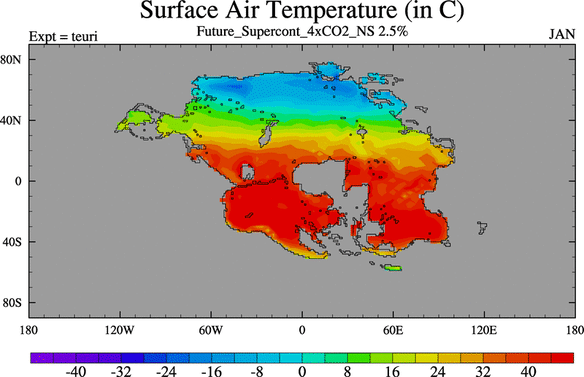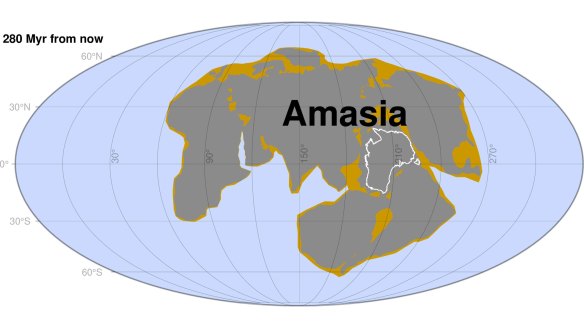By Angus Dalton
In 250 million years, for the first time since Pangea cracked apart, the continents of Earth will crash together into a new supercontinent dubbed Pangea Ultima. And humans will probably have very little chance of survival because life on the new supercontinent will be fatally hot.
The Earth’s crust consists of seven major tectonic plates which slide around on top of the hot, ductile, partially molten upper mantle. The shifting plates move continents around by a few centimetres each year.
The dynamics of these shifting plates split the last supercontinent, Pangea, and its remnants formed the world map as we know it. But every 400-600 million years, Earth’s landmasses crash back together again.
Pangea Ultima, also known as Pangea Proxima, is one configuration of this new supercontinent proposed by geologists.
Australia would swing up into China, and the Americas would close in on Africa. Meanwhile, Africa would ram into Europe and Arabia, hurling up a mountain range with peaks that could surpass Mount Everest and that stretch through Southern Europe and into Asia.
The continents would form a kind of ring around an inland sea, and the supercontinent would be swaddled in an enormous Pacific Ocean.

Hot, humid, and deadly: only 8 per cent of Pangea Ultima would be habitable, according to a new study, which would bring about the end of mammals.Credit: Dr Alexander Farnsworth, University of Bristol
But, according to new research that modelled the climate of this new landmass with a supercomputer, heat levels surpassing the mammalian threshold of survival could end a supremacy that began 65 million years ago with the extinction of dinosaurs.
The heat would be driven by CO2 belched from volcanoes and thermals. The sun would also burn more intensely – solar energy increases by about 1 per cent every 110 million years.
The researchers also accounted for continentality, which refers to the greater temperature range in the interior of continents compared to the coast, and the fact Pangea Ultima would form along the tropics and contain vast deserts.
The result conjures a vision of a sun-scorched supercontinent, inhospitable to mammalian life – even for those critters that burrow or shelter in caves.

One interpretation of Amasia is another possible supercontinent that could be more hospitable than Pangea Ultima.Credit: Curtin University
Said Alexander Farnsworth, senior research associate at the University of Bristol and lead author of the paper: “Widespread temperatures of between 40 and 50 degrees, and even greater daily extremes, compounded by high levels of humidity would ultimately seal our fate. Humans – along with many other species – would expire due to their inability to shed this heat through sweat.”
Humans and other mammals are imperilled if temperatures remain above 40 degrees for days on end.
Wet-bulb temperatures, which include the sapping effect of humidity, above 35 degrees can kill in six hours (parts of the Middle East, Asia and the Americas have approached and may exceed this deadly threshold in coming years due to climate change).
The authors write mammals might evolve to adapt to these extremes but note the upper limit of their heat tolerance hasn’t budged much in millions of years of evolution.

Dietmar Muller, professor of geophysics at the University of Sydney.Credit:
There are alternative interpretations of what the supercontinent might look like, but the authors say most of them would have a similar climate to Pangea Ultima.
The exception is Amasia, a duelling supercontinent theory backed by some Australian scientists.
Professor Dietmar Muller, a plate tectonics expert from the University of Sydney who wasn’t involved in the study, said Amasia would be more hospitable than the parched Pangea Ultima.
“A supercontinent at higher latitudes would not have the same effect [as Pangea Ultima] at all – temperatures would be more moderate.”
But Muller agrees with the authors’ point that tectonic movement is key to keeping Earth in the so-called “Goldilocks zone”, where water is available and life is possible.
“Plate tectonics play an extremely important role in helping drive the evolution of life on Earth and creating a habitable climate,” Muller said.
The authors also wrote in their Nature Geoscience paper that cosmic explorers should consider the arrangement of a planet’s continents, not just its distance from a sun, in future expeditions aimed at finding exoplanets that could sustain human life.
The Examine newsletter explains and analyses science with a rigorous focus on the evidence. Sign up to get it each week.